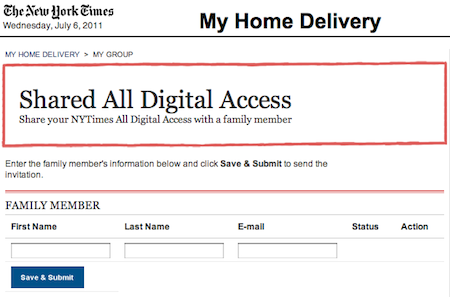
Are you a New York Times subscriber? Are you related to one? If so, today’s your lucky day: The Times, in an email just sent out to print subscribers, is announcing that subscribers will now be able to share their digital access with a family member of their choosing. Think of it as the Frank Rich Discount, bring-a-plus-one edition. (The Times is also offering the deal to digital-only types who subscribe to the most expensive, $35-every-four-weeks package.)
It’s an interesting move. For one thing, it’s another way for the Times to differentiate its price points, which for digital-only are currently $15 for web and smartphone app, $20 for web and tablet app, or $35 for web, smartphone, and tablet. That $35 top-tier item has always seemed a little high next to its peers, and bringing this sharing mechanism only to those subscribers could give another reason for some to pony up.
But, more interestingly, the move shifts the calculus of the NYT’s porous paywall, for which the locus of subscription has been a single person. In print, a family was able to share the paper among husband and wife, son and daughter — maybe even with a neighbor. Digital subscriptions, with their logic of one-subscription-per-person, reframed that community ethos: When the paper rolled out its pay meter, its core consumer became the individual, not the group.
So while today’s share-a-subscription move may be a way, of course, for the Times to collect more email addresses and other user data, and to build its user base, and to encourage Times subscribers to sync up their print and their digital accounts…it’s a move that also seems aimed at recapturing some of the communal aspects of paper subscription and consumption — just on a digital plane. (I’m sure the Times would love nothing more than to spark a few intra-family squabbles over who gets to share Mom’s digital access.)
And its language announcing the new policy bears that out. As of today, the Times stresses, digital subscribers can share digital access with a family member — not a friend, not a coworker, not an acquaintance, but an actual relative. “Now you can share your All Digital Access with a family member at no additional charge,” the email says. Click on the link included in the email, and you’re sent to a “Share All Digital Access” page that, though fairly sparse, repeats the term “family member” three times.

And in the Shared Access FAQ, the “family member” count jumps to seven.
Which is curious, since the invite page uses a text field that could be filled in with the name and email address of anyone, family or no. (Dear Colin Firth: You don’t know me, and we’re not related. But I’ve got a New York Times Digital Access invite with your name on it…)
Leaving aside the pesky philosophical questions (what is family, really?), what the move also means is that people who are already NYT subscribers, as of today, have been granted one of the more powerful perks of the early adopters: invitations to a fairly exclusive party. (You didn’t have to be on Twitter the day Google+ rolled out to appreciate the sway of the phrase “I’ve got invites.”) Which is a nice thing for the paper’s existing subscribers — and a nice incentive for more people to join their ranks.